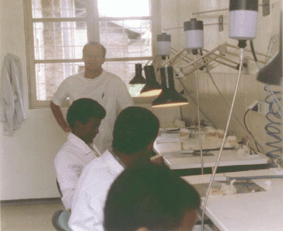
The dental laboratory

a lesson for dental therapists
At my arrival -October 1991- the situation in the dental laboratory inside the Dental Clinic of Addis Ababa Yekatit 12 Hospital, was, from a structural point of view and from job organization, not good.
On four available working places only one was equipped in a satisfactory way. The compressed air was unused for a compressor breakdown, the benches were not joined to the feeding gas system as the trimming machine to the hydraulic plant. The scarce illumination, supplied only by natural light plus two ceiling neon lamps didn't allowed accurate workmanship. The plaster bench was not ready and inside the laboratory reigned a chaos of models, prosthesis and material containers. The four local dental technicians, that managed the laboratory, weren't responsabilised by the dentists as concerned technical requisite and quality of the manufactured articles as well the delivery times.
Logically a dental laboratory structured and organized in these terms was able to produce only few articles with poor quality despite the elevated prosthesis demand.
This situation of disorder and abandonment of the dental lab even reflected in negative manner on the clinic management and on project objective request.
After evaluating the situation and in agreement with the team leader Dr. Fregonara and with the help of Medicus Mundi representative Eng. Osella, we started to make efficient and functional the whole dental laboratory.
The plaster bench was mounted, the compressor repaired and the trimming machine connected to the hydraulic plant. All the benches have been equipped with gas feed Bunsen burners replacing the alcohol torches. All the working place were equipped with an electric motor (drill) with relative speed regulator and hand piece in order to make each place independent and structured in a way to make ergonomic the job. Each place was furnished with an independent and adjustable light in order to make the operational field suitable for the work.
Every dental technician was responsible of his own job; from the casting of impressions up to prosthesis delivery.
Thank to these structural and organizational improvements, the laboratory was able to satisfy the dental clinic prosthesis requests in full respect of project qualitative scheduled standard.
In order to make more functional the relationship among clinic, laboratory and the jobs management within the laboratory itself was created a form. In this form the varied information collected from patient helps in job organization and construction.
Using this methodology was possible to effectuate a more precise evaluation of the quantity and type of produced prosthesis. Average weekly production was:
|
The dental laboratory |
a lesson for dental therapists |